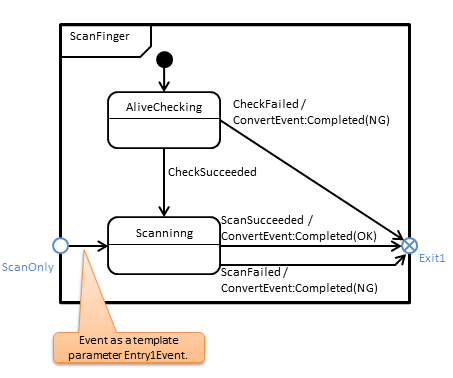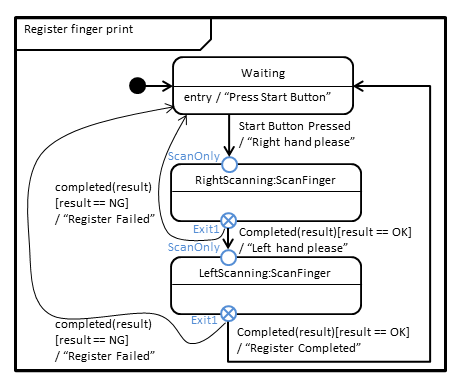
 |
Boost : |
Subject: [boost] [msm]entry point pseudo states and events (Re: [msm] orthogonal region and event consume)
From: Takatoshi Kondo (redboltz_at_[hidden])
Date: 2012-05-31 02:44:49
Hi Christophe,
I changed the subject. Current topic isn't concerned with orthogonal
region directly.
On Thu, May 31, 2012 at 5:43 AM, Christophe Henry
<christophe.j.henry_at_[hidden]> wrote:
> Hi Takatoshi,
>
>
>>> I read your ticket. Note that it's not UML-conform to have 2 transitions
>>> originating from Entry1 (11-08-06.pdf §15.3.8 page 551).
>>> After reading the Standard again twice, I realized that no example
>>> provided
>>> there displays any event on both transitions, which is really bad if it's
>>> what they mean. I need to have a look at other literature.
>
>
>> I read the section that you mentioned carefully. My interpretation of
>> UML specification is different from yours.
>> It's really difficult to explain my interpretation. So, I draw the
>> diagram. See the attached file.
>> Am I misunderstanding?
>
>
> I will not pretend I have the perfect understanding of the Standard. Here's
> my take. I also saw the sentence on top of your diagram and didn't fully
> understand it when reading the Standard. There is also the following
> sentence in the Standard:
>
> "An entry pseudostate is used to join an external transition terminating on
> that entry point to an internal transition
> emanating from that entry point".
>
> Which sounds logical because on your diagram the regions would not be
> orthogonal.
>
> This means you cannot have transitions triggered by different events leading
> to the entry point, not can you have different transitions leaving it. You
> will need more entry points.
>
> Caution: I am far from being sure I got it right. That's why I precised my
> definition of it in the doc. The implemented solution has the advantage that
> you have the normal transition handling, including multiple transitions and
> guards, events with data, base events, etc.
> What you don't have is entry in multiple regions, which only the fork
> currently provides, at the cost of lesser encapsulation.
> Correct or not, this is the part of the Standard I chose to implement pseudo
> entries.
>
> To be honest, I'm not of fan of pseudo entries. I prefer the vastly superior
> solution of entering a submachine the "normal" way, then letting a
> templatized, enable_if'd on_entry of the submachine do something clever with
> the event at compile-time.
Aha! I completely overlooked such approach. For example, we can choose the
initial state in submachine using mpl and initial_state typedef
instead of using entry_pseudo_state.
I believe that I've understood your design decisions. I also think
that following the UML standard blindly is not essential.
>> My goal is to improve sub-machines' re-usability. If we want to reuse
>> sub-machines in another state machines, sub-machines shouldn't know
>> the outside information.
>
>
> I agree but is it the case? I mean, if you send normal events to your
> submachine through your outer machine, it also needs to know them, right?
> I understand this as: "hi, I'm a submachine and I provide the following
> entry points: Entry1 requires Event1, Entry2 requires Event2, etc.". A bit
> like function parameters.
I wanted to explain that as follows:
"hi, I'm a submachine and I provide the following entry points: Entry1
accepts any events. Because I don't care that. "
Let me introduce more practical example that requires entry_pseudo_state.
ScanFinger.png is a sub-machine. This sub-machine's primary purpose is
to scan fingerprint. Before scanning, the sub-machine checks that
finger is alive or not. But it's optional. To skip this check
procedure, the entry point pseudo state ScanOnly is provided.
FingerPrintRegister.png is the parent state machine. It uses
ScanFinger as a sub-machine twice. In this scenario, alive checking is
not required. So, the parent machine uses ScanOnly enty_pt. In another
scenario, not mentioned here, might require the normal entry into
ScanFinger to check the finger is alive.
ScanFinger machine doesn't care about outer event. In
FingerPrintRegister, the states RightScnning and LeftScanning have
different incoming events for ScanOnly entry points. But any events
are accepted. And then, it's not referred.
Based on your suggestion, I introduce the base event class. As long as
the incoming event of entry point is not "none", this approach works
good.
struct AnyEvent {};
struct Completed: public AnyEvent {};
struct StartButtonPressed: public AnyEvent {};
(See 39_FingerPrintExampleBaseEvent.cpp)
If the incoming event is "none", the transition is stopped. Sometimes
I want to use "none" as incoming event for entry point in the same
sub-machine.
And it is impossible that msm::front::none inherits user event classes
such as AnyEvent.
I'm trying to find better approach to solve the above problem.
Thanks,
Takatoshi
>> See my second mail in this thread. My solution using templates
>> (entry_pseudo_event_template.cpp) requires the template parameters
>> same as the number of entry point pseudo states in sub-machine. It's
>> acceptable but if outgoing transition would be able to use none, I
>> would remove the template parameters.
>
>
>> In the above case, it is not required to support multiple incoming
>> transitions to one entry pseudo state. Because the instances of
>> sub-machine are different.
>
>
> In this case, maybe I could interest you in defining a base event class for
> Event1 and Event2, then making this base event the event triggering the
> inside transition. Your first example would be changed this way:
>
> struct BaseEvent {};
> struct Event1: public BaseEvent {};
> ...
> msmf::Row < Entry1, BaseEvent, State2_2, msmf::none, msmf::none >
>
>
>
> Regards,
> Christophe
>
> _______________________________________________
> Unsubscribe & other changes:
> http://lists.boost.org/mailman/listinfo.cgi/boost


Boost list run by bdawes at acm.org, gregod at cs.rpi.edu, cpdaniel at pacbell.net, john at johnmaddock.co.uk